
Oncology NEWS International
- Oncology NEWS International Vol 4 No 9
- Volume 4
- Issue 9
House committee Recommends Budget Increases for NIH, NCI
WASHINGTON--In a surprise move, the House Labor, HHS and Education Subcommittee of the House Appropriations Committee voted to increase NIH funding by about $642 million for FY 1996. NCI's 1996 budget of $2.25 billion represents a $31 million increase over the current budget.
WASHINGTON--In a surprise move, the House Labor, HHS and EducationSubcommittee of the House Appropriations Committee voted to increaseNIH funding by about $642 million for FY 1996. NCI's 1996 budgetof $2.25 billion represents a $31 million increase over the currentbudget.
To support these increases, the subcommittee recommended cutsin other health, labor and education programs.
The Appropriations Committee believes that NIH should allocatefunds on the basis of scientific opportunity; thus there are noearmarks by disease or research mechanism, and no separate fundingfor the Office of AIDS Research. No further funds are providedto support the NCI study of tobacco industry campaign contributionsto state legislators.
Articles in this issue
over 30 years ago
New Probe Detects Fusion of bcr/ablover 30 years ago
Avon's Breast Cancer Crusade to Offer 'Pink Ribbon' Pensover 30 years ago
Take a Behind the Scenes Look at ODACover 30 years ago
Michigan Cancer System Named for Womanover 30 years ago
High-Dose Chemo Patients to Get Stem Cells With the MDR-1 Geneover 30 years ago
Report on Minority Health Finds Few Black Oncologistsover 30 years ago
Where Are We Going and What Questions Do We Need to Ask?over 30 years ago
Hodgkin's Disease Patients Sought for Trial of MoAbNewsletter
Stay up to date on recent advances in the multidisciplinary approach to cancer.


















































































